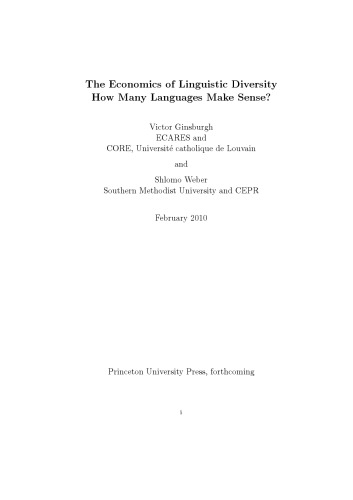

Most ebook files are in PDF format, so you can easily read them using various software such as Foxit Reader or directly on the Google Chrome browser.
Some ebook files are released by publishers in other formats such as .awz, .mobi, .epub, .fb2, etc. You may need to install specific software to read these formats on mobile/PC, such as Calibre.
Please read the tutorial at this link: https://ebookbell.com/faq
We offer FREE conversion to the popular formats you request; however, this may take some time. Therefore, right after payment, please email us, and we will try to provide the service as quickly as possible.
For some exceptional file formats or broken links (if any), please refrain from opening any disputes. Instead, email us first, and we will try to assist within a maximum of 6 hours.
EbookBell Team

5.0
80 reviews
ISBN 10: 0691136890
ISBN 13: 9780691136899
Author: Victor Ginsburgh, Shlomo Weber
In the global economy, linguistic diversity influences economic and political development as well as public policies in positive and negative ways. It leads to financial costs, communication barriers, divisions in national unity, and, in some extreme cases, conflicts and war--but it also produces benefits related to group and individual identity. What are the specific advantages and disadvantages of linguistic diversity and how does it influence social and economic progress? This book examines linguistic diversity as a global social phenomenon and considers what degree of linguistic variety might result in the greatest economic good.
Victor Ginsburgh and Shlomo Weber look at linguistic proximity between groups and between languages. They describe and use simple economic, linguistic, and statistical tools to measure diversity's impact on growth, development, trade, the quality of institutions, translation issues, voting patterns in multinational competitions, and the likelihood and intensity of civil conflicts. They address the choosing of core languages in a multilingual community, such as the European Union, and argue that although too many official languages might harm cohesiveness, efficiency, and communication, reducing their number brings about alienation and disenfranchisement of groups.
Demonstrating that the value and drawbacks of linguistic diversity are universal, How Many Languages Do We Need? suggests ways for designing appropriate linguistic policies for today's multilingual world.
Chapter 1: My Language Is My Homeland
This chapter likely introduces the intrinsic value and cultural importance of language, setting the stage for the economic analysis.
Chapter 2: Linguistic Policies, Disenfranchisement, and Standardization
Explores the impact of different linguistic policies.
Discusses concepts like linguistic disenfranchisement (when a group's language is not official).
Examines the effects of language standardization.
Chapter 3: How Far Is Nostratic?
This chapter delves into linguistic proximity and the concept of language families (like the hypothetical Nostratic).
It likely introduces methods for measuring linguistic distances.
Chapter 4: Distances Matter
Continues the theme of linguistic distances, possibly discussing their measurement and impact on communication and economic interactions.
Chapter 5: Individual Communicative Benefits
Analyzes the benefits individuals gain from speaking certain languages.
Looks at the utility and advantages of multilingualism from an individual perspective.
Chapter 6: Diversity and Disenfranchisement Indices
Details the construction and application of indices to measure linguistic diversity and disenfranchisement.
Chapter 7: Applications
Applies the theoretical frameworks and indices to real-world scenarios.
Examples might include the impact on growth, development, and trade.
Chapter 8: A Case Study in Linguistic Policy
Presents a detailed analysis of a specific linguistic policy case, such as the European Union's multilingual approach.
Chapter 9: Conclusions
Summarizes the findings and provides policy recommendations.
the economics of linguistic diversity
the economics of diversity
linguistic diversity economic growth
the economics of discrimination
economics of language
linguistics and economics
Tags: Victor Ginsburgh, Shlomo Weber, Economics, Linguistic